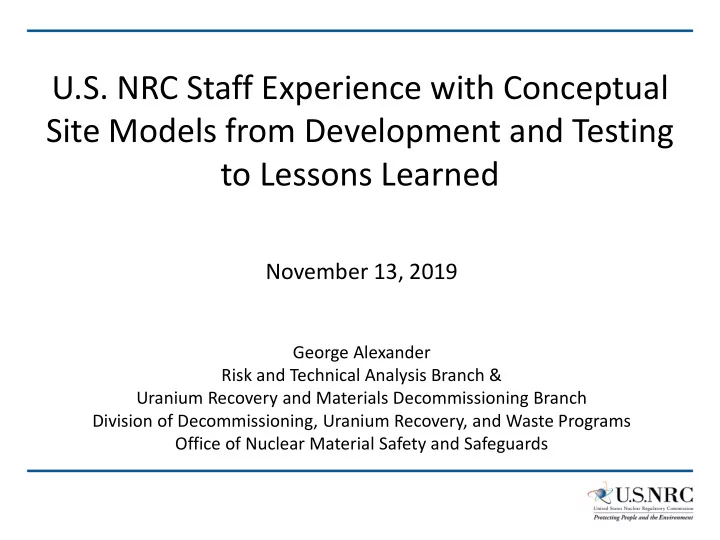

U.S. NRC Staff Experience with Conceptual Site Models from Development and Testing to Lessons Learned November 13, 2019 George Alexander Risk and Technical Analysis Branch & Uranium Recovery and Materials Decommissioning Branch Division of Decommissioning, Uranium Recovery, and Waste Programs Office of Nuclear Material Safety and Safeguards
Definition and Development of Conceptual Site Models Adapted from ASTM E1689.6648 Conceptual Site Model - a written or pictorial representation of an environmental system and the biological, physical, and chemical processes that determine the transport of contaminants from sources through environmental media to environmental receptors within the system. Adapted from NUREG 1757 Vol 2. Rev.1 Development of conceptual models is a subjective process based on interpretation of often limited site data. Key issues in developing the conceptual site model: (a) identifying the important site features, events, and processes that need to be included in the conceptual model; (b) deciding among possible competing interpretations of the site data; and (c) determining the level of detail needed to describe those features and processes 2
Outline of Conceptual Site Model • Site Information - Historical and Current Site-Related Activities • Determination of Background Concentrations for Contaminants of Concern • Characterization of Source Term • Transport pathways to the accessible environment • Potential Receptors Adapted from ASTM E1689.6648 Standard Guide for Developing Conceptual Site Models for Contaminated Sites 3
Site Information: Site Layout Site history • o Mill operated from 1958-1990 o Groundwater restoration began in 1977 Large and small tailings • piles Network of injection • and extraction wells Three Evaporation • Ponds (EP1, EP2, EP3) Two collection ponds • Reverse Osmosis (RO) • and Zeolite groundwater treatment facilities Adjacent communities • Adapted from Google Earth 4
Determination of Background Often limited historical data (i.e., pre-operational) Review of background concentrations by EPA • • Natural variability of hydrogeologic parameters with USGS field studies & analyses • Concurrent review by Homestake of the data and geochemistry • Collection of information Geophysical and geochemical analyses by USGS • • Upgradient sources • Adapted from USGS Publications - Harte et al. (2019) and Blake et al. (2019) 5
Determination of Background Differentiating • between natural vs anthropogenic sources Monitoring wells • o Location o Quantity o Completion records o Integrity Adapted from 2018 Annual Monitoring Report/Performance Review for Homestake’s Grants Project (ADAMS Accession No. ML19101A370 7
Determination of Background Bluewater Site Adapted from 2017 Uranium Plumes in the San Andres-Glorieta and Alluvial Aquifers At the Bluewater, New Mexico, Disposal Site (ADAMS Accession No. ML19081A121) 8
Source Term Historical placement can • affect site stability and contaminant release Composition of tailings can • affect contaminant release and transport Slimes consolidation and • seepage is a long-term process Uncertainties • o Infiltration rate o Chemical composition o Solubilities o Seepage/drainage rate with time Adapted from 2018 Annual Monitoring Report/Performance Review for Homestake’s Grants Project (ADAMS Accession No. ML19101A370 9
Site Characterization Complex subsurface Series of underlying aquifers • Paleochannels • Differing flow directions • Subcropping of aquifers • Mixing of aquifers • Faulting • Adapted from 2018 Annual Monitoring Report/Performance Review for Homestake’s Grants Project (ADAMS Accession No. ML19101A370 10
Site Characterization Adapted from 2018 Annual Monitoring Report/Performance Review for Homestake’s Grants Project (ADAMS Accession No. ML19101A370 11
Site Characterization Adapted from 2018 Annual Monitoring Report/Performance Review for Homestake’s Grants Project (ADAMS Accession No. ML19101A370 12
Site Characterization Heterogeneity of the • alluvium Characterization – • How much? Abstraction/ • Simplification – To what extent? Representation of key • features Effective continuum vs • Dual porosity/ permeability Adapted from 2016 Expanded TPP Pilot Test in the Alluvial Aquifer: Summary Report for Grant’s Reclamation Project (ADAMS Accession No. ML16351A351) 13
Groundwater Restoration Transport pathways • Restoration began in • 1977 NRC approved • Groundwater Corrective Action Plan in 1989 Communities • o Involvement o Public water supply o Well prohibition Upcoming revision to • the Groundwater Correction Action Plan Adapted from 2018 Annual Monitoring Report/Performance Review for Homestake’s Grants Project (ADAMS Accession No. ML19101A370 14
Groundwater Restoration – Source & Plume Control Alluvial Groundwater Collection and Injection Wells • Five Components o Source control o Plume control o Reverse Osmosis o Evaporation o Land Application • Evolution of activities o Injection wells o Extraction wells o Monitoring wells o Zeolite systems o Evaporative Capacity • Performance Monitoring o Groundwater plume o Radon o Evaporation Pond leakage o Erosion Adapted from 2018 Annual Monitoring Report/Performance Review for Homestake’s Grants Project (ADAMS Accession No. ML19101A370 15
Operational Flows Adapted from 2018 Annual Monitoring Report/Performance Review for Homestake’s Grants Project (ADAMS Accession No. ML19101A370 16
Alluvial Groundwater Uranium Concentration 1999 Adapted from 2018 Annual Monitoring Report/Performance Review for Homestake’s Grants Project (ADAMS Accession No. ML19101A370 17
Alluvial Groundwater Uranium Concentration 2014 Adapted from 2018 Annual Monitoring Report/Performance Review for Homestake’s Grants Project (ADAMS Accession No. ML19101A370 18
Alluvial Groundwater Uranium Concentration 2018 Adapted from 2018 Annual Monitoring Report/Performance Review for Homestake’s Grants Project (ADAMS Accession No. ML19101A370 19
Lessons Learned The impacts due to conceptual model uncertainty can significantly exceed • those due to parameter uncertainty Iterative process of collecting data, identifying potential scenarios, • developing conceptual and numerical models, and analyzing results Obtain key data to support each conceptual site model and update as • needed Communicate uncertainties with each conceptual site model • The use of multiple independent modelers and reviewers (i.e., a • structured peer review) can help to identify conceptual model uncertainty All conceptual site models that are consistent with available information • should be evaluated Interactions with local communities provide information for the modelers • as well as the stakeholders and help to build confidence. 20
Recommend
More recommend